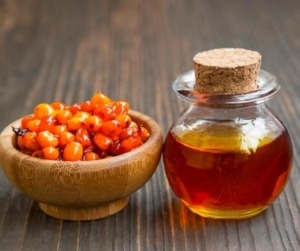Sea buckthorn (Hippophae rhamnoides) has traditionally been used for nutritional and medicinal purposes. Plenty of studies have shown a wide range of biological activities and potential health benefits of the plant. The pulp of sea buckthorn berries contains abundant vitamins, minerals, amino acids, and polyphenolic compounds, which contribute to human health benefits. Sea buckthorn pulp oil and seed oil have traditionally been used for treating mucosal disorders such as dermatitis. Additionally, dried or fresh leaves are prepared for nutritious herbal tea as they are rich in nutraceutical components.
Aqueous tear fluid is secreted from the lacrimal gland (LG), and constantly flows over the ocular surface to create a moistened, properly controlled environment for the conjunctiva and avascular cornea. Dry eye syndrome is characterized by impairment of the status of the tear film, which causes ocular discomfort accompanied by visual impairment.
A recent study showed that the dietary intake of sea buckthorn oil attenuated tear hyperosmolality and subjective symptoms in patients with dry eye syndrome. This study suggested that sea buckthorn oil products have the potential to improve the secretory function of tears in dry eyes. Sea buckthorn oil contains a high content of various polyunsaturated and saturated fatty acids. These fatty acids are essential nutrients for energy sources, vital structural components and important cell signaling molecules with multiple biological effects.
In the present study, we assessed the usefulness of sea buckthorn oil products on dry eyes. Specifically, we evaluated the effects of the constituent polyunsaturated and saturated fatty acids found in sea buckthorn oil on tear secretion capacity and studied their anti-inflammatory effects on lacrimal glands using two murine dry eye models.
Sea buckthorn pulp oil showed a more potent effect to preserve tear secretion than sea buckthorn seed oil. Sea buckthorn pulp oil contains higher contents of palmitic acid, oleic acid, and palmitoleic acid and lower contents of Linoleic Acid and alpha-Linolenic Acid compared to sea buckthorn seed oil.
Additionally, animal data showed that high levels of palmitic acid and oleic acid, and not of palmitoleic acid, were present in mouse serum in normal conditions, and that the administration of sea buckthorn pulp oil significantly increased the serum palmitoleic acid level.
Together with the result that palmitoleic acid and not palmitic acid corrected the decrease in tear secretion in the dry eye model, it is suggested that the constituent palmitoleic acid of sea buckthorn pulp oil is an active component for resolving tear secretion dysfunction in dry eye conditions.
Palmitoleic acid is not only an intermediate of the fatty acid metabolic cascade, but it also exhibits a role in various physiological functions. This fatty acid acts as a major signaling lipid hormone that strongly stimulates muscle insulin action which leads to improving glucose metabolism and suppressing hepatosteatosis with anti-inflammatory effects.
Supplementation with palmitoleic acid has been shown to attenuate liver or vascular inflammation caused by metabolic stress. Inflammation is potentially involved in the pathogenesis of dry eye. Consistent with the effects on the tear secretion capacity, the changes in cytokine and chemokine expression in the lacrimal gland after repeated treatment with sea buckthorn pulp oil were similar to those with palmitoleic acid. Interleukin-12p40 (IL-12p40), the bioactive cytokine of IL-12, is a pivotal inflammatory mediator in barrier tissues, and induces T lymphocytes to express Interferon-γ (IFN-γ). IFN-γ and interleukin-1α (IL-1α) are pleiotropic cytokines involved in the immune response and are potent chemoattractants for eosinophils and lymphocytes (Eotaxin-1) in the course of the inflammatory processes. Interleukin-6 (IL-6) is a cytokine produced by immune and non-immune cells, and it acts as a mediator for several acute-phase inflammatory responses. RANTES is a CC chemokine targeting eosinophils, T cells, and monocytes, and is produced by a variety of cell types including platelets and fibroblasts. IL-1α, IL-6, IL-12, IFN-γ, and RANTES have been documented to be increased in the tears of dry eye patients. Eotaxin, IFN-γ, and RANTES have been shown to be involved in lacrimal gland destruction.
Therefore, our results suggest that palmitoleic acid exhibits the potential to preserve the tear secretion capacity in dry eye conditions by suppressing lacrimal gland inflammation. Further investigations should address the mechanisms underlying the relationship between the anti-inflammatory effect of palmitoleic acid and lacrimal gland secretory function.
A Mediterranean diet has been identified as a specifically healthy diet pattern with favorable effects on various health outcomes. Higher levels of consumption of olive oil are considered the main characteristics of this diet.
In the present study, to estimate the potency of effectiveness of sea buckthorn pulp oil as an intervention to prevent dry eye, the effect of sea buckthorn pulp oil on the preservation of tear secretion was compared with olive oil using rat blink-suppressed dry eye model. The dry eye model used in this study was created to simulate the effect of the excessive use of digital devices by repeatedly exposing rats to a daily stressful condition—persistent strain by swinging in combination with exposure to an evaporation-promoting environment. Consistent with the findings of the epidemiological study on VDT workers, this rat model showed a persistent decrease in tear secretion that was dependent on the strain strength. Contrary to expectations, repeated treatment with sea buckthorn pulp oil, not olive oil, significantly restored tear secretion in the rat blink-suppressed dry eye model that mimics the situation of office workers.
Our analytical results of oil products showed that the fatty acid composition of olive oil differs from that of sea buckthorn pulp oil because of its high oleic acid (78.4 mg/100 g in this study) and low saturated and unsaturated fatty acid content, including palmitoleic acid (0.6 mg/100 g in this study) contents, compared to sea buckthorn pulp oil. This superior effect of sea buckthorn seed oil compared to olive oil on aqueous tear secretion in dry eye conditions was possibly due to the higher content of palmitoleic acid. Together with the variety of health benefits of sea buckthorn based on human and animal studies, the present study revealed that the dietary intake of sea buckthorn pulp oil as a natural ingredient not only ameliorates dry eye but also shows health benefits similar to olive oil.
In conclusion, sea buckthorn pulp oil is a potent candidate for dry eye treatment through the suppression of inflammation of the tear secretion organ, the lacrimal gland. Omega-7 monounsaturated fatty palmitoleic acid, a characteristic fatty acid in sea buckthorn pulp oil, was identified as an active agent. Further clinical studies involving the dietary intake of palmitoleic acid and focused on information technology–associated dry eye patients will help clarify the efficacy of sea buckthorn and establish new therapeutic interventions for this disease.

Leave A Comment